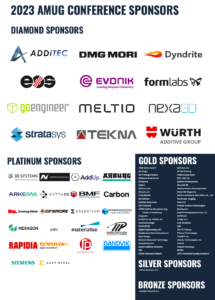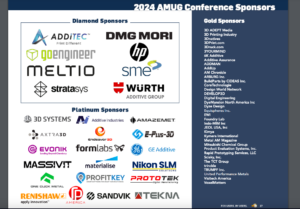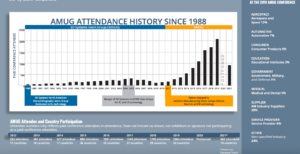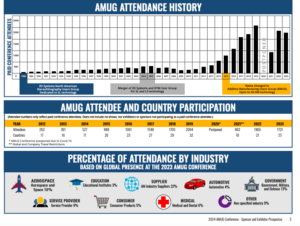“The 3D printing industry would probably be dead in the water if it weren’t for the U.S. government,” a representative of the US military said at the 2024 Additive Manufacturing Users Group (AMUG) conference. Of course, having been an employee of said government, he may have been a little biased.
He did have a point, however. The public markets and, according to AM Ventures Managing Partner Arno Held at this year’s Additive Manufacturing Strategies (AMS), private investment into the 3D printing sector have slowed to a near standstill. As a result, the theme of 2023 seemed to be “RIP 3D printing.” Will it be resurrected in 2024? This year’s AMUG suggested that, of course, it had never actually died, but it may be iterating a new geometry.
As made most palpable at the secret dinner getaway at the multi-level nightclub and music venue Radius Chicago, the camaraderie of AMUG was still on full display in 2024. There, Mara Hitner, Vice President of Strategic Partnerships at MatterHackers, showcased the full gamut of her skills by playing 80s hits on stage at the venue before a crowd of AM Dinos, newcomers, and more. Thanks to the wonderful community cultivated by the incredible AMUG team, we also got to witness Alex Campbell, an undergraduate aerospace student from Ohio State University, receive the Guy E. Bourdeau Scholarship for students in additive manufacturing (AM). Phil Rufe, an Assistant Professor in the School of Engineering at Eastern Michigan University, was selected for the Randy Stevens Scholarship for educators in AM, as well.

AMUG DINO and AM consultant Stefan Ritt giving his International Report at AMUG 2024.
However, it did seem as though it wasn’t the private investors that were driving the sector forward. Instead, it was the public sector. This would already be clear to anyone who’s been following the policies put forth by the Biden-Harris administration in the U.S. and other programs abroad. It was similarly evident at AMUG, where it’s commonplace to be randomly seated next to a government representative during the networking lunch. One year, you might find yourself seated next to a military engineer interested in 3D printing cockpit simulators. Another year, it could be someone working in an Air Force electronics research lab. In 2024, the norm would be both: on one side, a military engineer, and on the other, an electronics 3D printing specialist from a military contractor.
Meanwhile, military funding, including Small Business Innovation Research awards. The CEO of one notable 3D printing startup said that the firm had gotten three SBIR awards from December 2023 to now, totaling several million dollars. Another from a stealth mode company said that much of what their firm was doing involved defense contractors.
Andrew Littlefield, a mechanical engineer from the U.S. Army CCDC Armaments Center at Benét Labs, relayed the story he’d shared at Mobility | Medical goes Additive 2023 Annual Meeting, in which a Velo3D Sapphire XC 1MZ was used to 3D print a muzzle break for a howitzer. The print time alone was an astounding 11 days, and the part cost exceeded $50,000. While he said that 3D printing has so far proven not to be ideal for large-caliber weapons when it comes to complexity and cost, it was chosen in this case for the turnaround time.
More objectively, however, the corporate presence was less pronounced compared to 2023, with some names not in attendance that one might have expected. For instance, companies that were listed as participating either with booths or as sponsors in 2023, but not in 2024 included: ARKEMA, Carbon, Inkbit, Quickparts, and Oerlikon. There were also significant differences in sponsorship, with EOS, Formlabs, Nexa3D, Evonik, Siemens, BMF, Xact Metal, Lithoz, voxeljet, Desktop Metal, and Additec dropping their levels of support this year. This, however, was balanced by increased support from the likes of HP, Nikon, SME, GE Additive, ADDMAN, Visitech, and One Click Metal.
Some of these are more notable than others. For instance, in the past, Carbon made it a point to unveil news ahead of or at the event, whereas this year, the digital light processing company was not even present. Desktop Metal, too, opted out. This is more reflective of the current financial situation for the industry than it is of AMUG, but it does perhaps point us toward where the sector is heading.
For instance, AMUG, which began as the 3D Systems users’ group due to the corporation’s invention of the technology, reflects the “users” of 3D printing. However, as the AM industry is being incorporated into the larger manufacturing sector, it may be that sectors outside of 3D printing are increasingly becoming the users.
Based on the data AMUG provides to its attendees, the Aerospace sector experienced a slight decrease in participation at the event from 12% in 2019 to 10% in 2023. Similarly, the Automotive sector saw a reduction in its representation from 7% to 4%. In contrast, the Government, Military, and Defense sector increased its presence from 8% in 2019 to 13% in 2023. Other areas such as Consumer Products and Educational Institutes maintained stable participation rates at 5% and 3%, respectively, across both years. The Medical and Dental sector showed a slight increase, moving from 5% to 6%.
Case Study of a Case Study: ASTRO & CAM-QT
While bustling AM professionals animated the Chicago Hilton’s halls, and attendees clustered around the booths piled with swag and brochures that filled the hotel’s basement, the real action was happening in the ballrooms and salons. This is where the speakers and panelists presented and discussed, and virtually every major subdivision within the AM industry had its own session. If there’s one drawback to that, it’s that it makes it difficult to choose what you most want to sit in on. It may not be the one you’d expect, but to us, one presentation in particular stood out on the agenda as not to be missed.
It didn’t disappoint: sticking with the main theme thus far of the public sector, the presentation was Douglas Greenwood’s update on the ongoing progress of the CAM-QT project. If you don’t know what this is, that’s most likely because there are seemingly infinite government-funded AM projects in-progress right now, all with names along the same lines. As Greenwood said in his presentation, “If there’s one thing we need, it’s another acronym.”
For instance, the acronym for the organization Greenwood is working for, in charge of managing CAM-QT, is the Applied Science and Technology Organization (ASTRO) America, a 501(c)(3) think tank based in Florida. CAM-QT stands for “Common Additive Manufacturing Qualification Template”. XWhile it’s certainly exhausting to try to keep track of all the acronyms floating around in the government space, these are two that everyone in the AM industry should remember.
CAM-QT began in July of last year, with ASTRO America receiving $1 million in funding from America Makes for its participation in the project. ASTRO’s partners on CAM-QT are GE, Pratt & Whitney, and AM Forward founding member Honeywell. Although GE Aerospace isn’t an AM Forward member, GE Additive is, and Pratt & Whitney is a subsidiary of RTX, another of the initiative’s founding members.
Greenwood, an engineer and AMUG DINO, is the point of contact for GE on the CAM-QT project. (There is a counterpart to Greenwood working with both Honeywell and ASTRO, as well as one working with both Pratt & Whitney and ASTRO.) Most specifically, the purpose of CAM-QT is to establish Installation Qualification (IQ) and Operational Qualification (OQ) requirements for printers producing in-service metal parts used in aircraft engines.
As Greenwood’s presentation made clear, however, the central involvement of ASTRO and the aircraft OEMs in AM Forward means that CAM-QT is also a testing ground for achieving AM Forward objectives. Thus, the presentation provided crucial insight into what exactly the day-to-day operations of AM Forward entail.
As the Biden administration established in its rollout of AM Forward in May 2022, the purpose of the initiative is to lower the barriers to AM adoption for small and medium enterprises (SMEs) through a three-pronged approach: helping SMEs access capital, develop and retrain the associated workforce, and qualify AM processes. According to Greenwood, though, from the participants’ perspective, process qualification is still the biggest obstacle standing in the way of accelerating adoption by new users.
This is what makes developing a common set of qualification criteria amongst users such a vital task. Interestingly, one of the key tools Greenwood says that CAM-QT is using to build the foundation for that criteria is good old-fashioned Excel spreadsheets. ASTRO sent spreadsheets to each company to submit plans for both installation and calibration & verification. The engineer noted that, at the project’s outset, the ASTRO team expected there would be major commonality between the aerospace manufacturers on the IQ/OQ criteria — overlap between “at least 2 of the 3” aircraft OEMs, according to Greenwood.
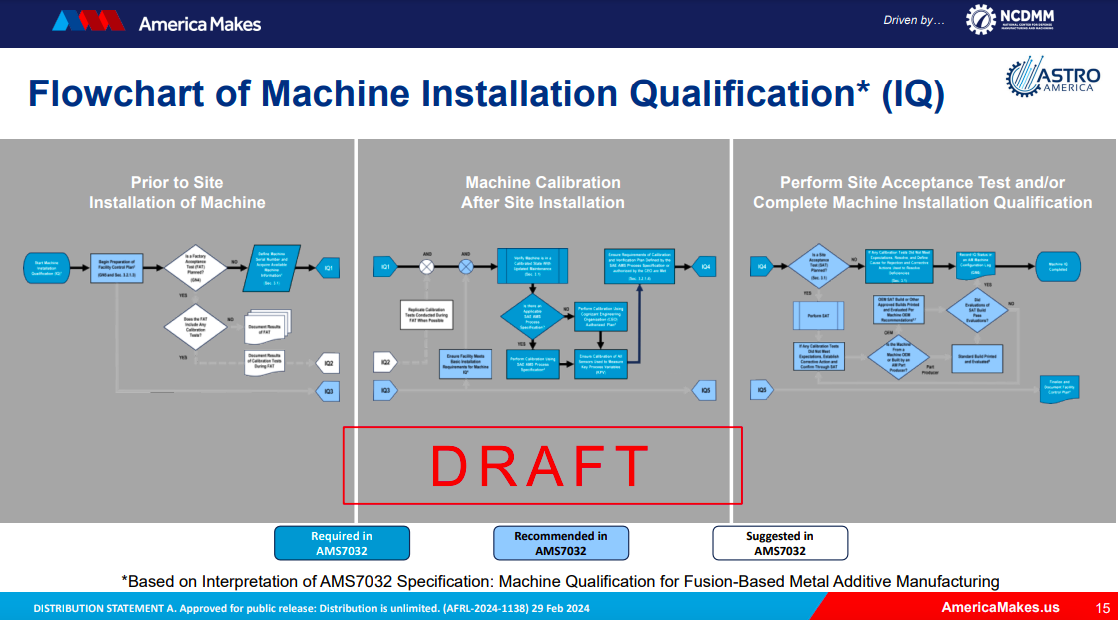
In fact, not only was there overlap between all three aerospace OEMs, but there was “significant commonality… for more than 90% of the IQ/OQ elements surveyed.” The elements for the calibration & verification plan included things like “make and model of the instrument calibrated”, “required calibration accuracy”, “any limitations or restriction of the calibration.”
The project has been given the go-ahead to move on to Phase 2, with Greenwood noting that ASTRO has started to work on a more comprehensive template based on the results of Phase 1. In addition to IQ and OQ, Phase 2 may also include Performance Qualification (PQ) in the template.

It may sound like tedious drudgery, but this is what it’s going to take to standardize the industry. This is the sort of thing that amounts to real action. And to be sure, standardizing the industry will require this, but on a much larger scale. CAM-QT is an excellent model for others to follow, and the companies involved are giants, but they’re still just three companies.
Along those lines, an industry insider called it a “noble effort”, but added that — precisely because the enormity of the companies involved makes them unrepresentative of the wider US manufacturing sector — the qualification process may not be scalable. That is, for instance, contract manufacturers simply don’t have the same workforce and resources that the primes have to deal with a printer that isn’t performing optimally. In order for any such qualification process to truly succeed as envisioned, it will have to be tested in a much broader fashion, and can’t just be the work of a few manufacturing giants. More pressingly, it has to be proven to work at the level of SMEs, and to be effective across the gamut of AM ecosystems.
Even if they’re the most important, it couldn’t be easier to see why these issues tend to draw far less attention than most other aspects of the industry, especially in contexts like conferences. Qualification processes are real, but they’re boring. By comparison, cool parts may be fake, but they’re entertaining. On the other hand, as was already pointed out, everyone had a choice of many different tracks and places to be, and the room was packed when Greenwood was speaking. It may be anecdotal, but people seem to be starting to get it.
Subscribe to Our Email Newsletter
Stay up-to-date on all the latest news from the 3D printing industry and receive information and offers from third party vendors.
Print Services
Upload your 3D Models and get them printed quickly and efficiently.
You May Also Like
Heating Up: 3D Systems’ Scott Green Discusses 3D Printing’s Potential in the Data Center Industry
The relentless rise of NVIDIA, the steadily increasing pledges of major private and public investments in national infrastructure projects around the world, and the general cultural obsession with AI have...
Formlabs Teams Up with DMG MORI in Japan
In late June, Nick Graham, Chief Revenue Officer at Formlabs, announced on LinkedIn that the company had partnered with DMG MORI, one of the world’s leading machine tool companies, to...
EOS in India: AM’s Rising Star
EOS is doubling down on India. With a growing base of aerospace startups, new government policies, and a massive engineering workforce, India is quickly becoming one of the most important...
3D Printing News Briefs, June 25, 2025: R&D Materials, 3D Printed Veneers, & More
In today’s 3D Printing News Briefs, 3DXTECH has launched a program that gives customers early access to experimental materials, and the first Lithoz CeraFab Multi 2M30 in the Czech Republic...


